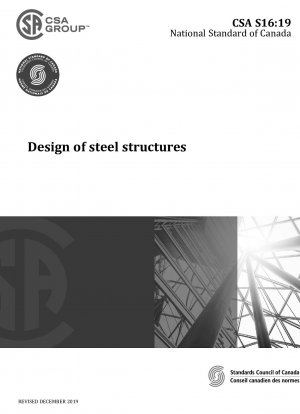CSA S16-2019
- Standard No.
- CSA S16-2019
- Release Date
- 1970
- Published By
- /
- Latest
- CSA S16-2019
- Scope
- 1 Scope and application 1.1 General This Standard provides rules and requirements for the design, fabrication, and erection of a broad range of steel structures based on limit states design approach. The term “steel structures” refers to structural members and frames that consist primarily of structural steel components, including structural steel acting compositely with concrete, and detail parts, welds, bolts, or other fasteners required in fabrication and erection. This Standard also applies to structural steel components in structures framed in other materials. The clauses related to fabrication and erection serve to show that design is inextricably a part of the design-fabrication-erection sequence and cannot be considered in isolation. For matters concerning standard practice pertinent to the fabrication and erection of structural steel not covered in this Standard, see Annex A. 1.2 Requirements Requirements for steel structures such as bridges, antenna towers, offshore structures, and cold-formed steel structural members are given in other CSA Standards. 1.3 Application This Standard sets out minimum requirements and is expected to be used only by engineers competent in the design of steel structures. It applies unconditionally to steel structures, except that supplementary rules or requirements might be necessary for a) unusual types of construction; b) mixed systems of construction; c) steel structures that i) have great height or spans; ii) are required to be movable or be readily dismantled; iii) are exposed to severe environmental conditions; iv) are exposed to severe loads such as those resulting from vehicle impact or explosion; v) are required to satisfy aesthetic, architectural, or other requirements of a non-structural nature; vi) employ materials or products not listed in Clause 5; or vii) have other special features that could affect the design, fabrication, or erection; d) tanks, stacks, other platework structures, poles, and piling; and e) crane-supporting structures. 1.4 Other standards The use of other standards for the design, fabrication, erection, and/or inspection of members or parts of steel structures is neither warranted nor acceptable except where specifically directed in this Standard. The design formulas provided in this Standard may be supplemented by a rational design based on theory, analysis, and engineering practice acceptable to the regulatory authority, provided that nominal margins (or factors) of safety are at least equal to those intended in the provisions of this Standard. The substitution of other standards or criteria for fabrication, erection, and/or inspection is expressly prohibited unless specifically directed in this Standard. 1.5 Terminology In this Standard, “shall” is used to express a requirement, i.e., a provision that the user is obliged to satisfy in order to comply with the standard; “should” is used to express a recommendation or that which is advised but not required; and “may” is used to express an option or that which is permissible within the limits of the Standard. Notes accompanying clauses do not include requirements or alternative requirements; the purpose of a note accompanying a clause is to separate from the text explanatory or informative material. Notes to tables and figures are considered part of the table or figure and may be written as requirements. Annexes are designated normative (mandatory) or informative (non-mandatory) to define their application.
CSA S16-2019 history
- 1970 CSA S16-2019
- 2014 CSA S16-2014 Rules for Designing Steel Frames (Eighth Edition; Integrate Errata: October 2015)
- 2010 CSA S16-2009 Règles de calcul des charpentes en acier
